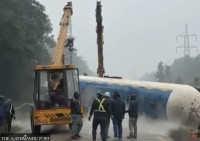National
Foreign Ministry statement regarding Lipulekh welcome but needs to be translated into action, say analysts
According to foreign policy experts, the statement is just a press release and needs to be followed up with diplomatic notes that assert Nepal’s claim over the disputed area..jpg&w=900&height=601)
Anil Giri
On February 15, in his special address to Parliament, Prime Minister KP Sharma Oli said that his government was preparing to reclaim all of Nepal’s lands encroached upon by India.
At that time, the Oli administration was facing criticism for its diplomatic failures after India in November included Kalapani, which Nepal claims as its own, within its borders in a new political map published in line with New Delhi’s decision to split up Jammu and Kashmir as federal territories.
“All historical evidence and facts show that Kalapani, Lipulekh and Limpiyadhura are our territories,” said Oli in response to queries as to when the government will hold talks with India about Kalapani and when it will make public a new map showing the territories that Nepal claims as its own.
“Printing a new map is no big deal, a new map can be printed very soon,” Oli said in response. “We are working to reclaim our lands.”
After rising public furore over India’s inclusion of Kalapani within its borders, Nepal had sought a date from Delhi to hold talks, only to receive a cold shoulder.
A little less than three months later, hours before the commencement of the budget session of Parliament, New Delhi caught Nepali officials and politicians by surprise when it announced that it had opened a road link via Lipulekh, part of the disputed territories.
India’s Ministry of Defence announced on Friday that Defence Minister Rajnath Singh inaugurated the link road from Dharchula to Lipulekh, identifying Lipulekh as the “China border”.
“Raksha Mantri today inaugurated the Link Road from Dharchula to Lipulekh (China Border) famously known as Kailash-Mansarovar Yatra Route,” the Indian Defence Ministry tweeted on Friday.
A day later, Nepal, in an official statement, said that India opening a road via Lipulekh was against the understanding reached between the two countries and urged the Indian government to refrain from carrying out any activity inside Nepali territory.
“The Government of Nepal has learnt with regret about the ‘inauguration’ yesterday by India of ‘Link Road’ connecting to Lipu Lekh (Nepal), which passes through Nepali territory [SIC],” the Ministry of Foreign Affairs said in a statement on Saturday. “The Government of Nepal has consistently maintained that as per the Sugauli Treaty (1816), all the territories east of Kali (Mahakali) River, including Limpiyadhura, Kalapani and Lipu Lekh, belong to Nepal.”
The ministry said that India’s “unilateral act” runs against the understanding reached between the two countries at the highest political level that a solution to the boundary dispute would be sought via diplomatic negotiation.
“The government of Nepal remains committed to seeking a diplomatic solution to boundary issues on the basis of the historical treaty, documents, facts and maps in keeping with the spirit of close and friendly ties between the two countries,” said the ministry.
Lipulekh is a strip of land on the northwestern edge of Nepal, lodged between Nepal, India and Tibet. While some call it a tri-junction between these three countries, Nepal has been claiming the southern part of the pass and has refused to recognise it as a tri-junction.
Earlier, in 2015, Nepal had written to both India and China after the two countries signed an agreement to expand a trade route via Lipulekh.
While many have welcomed the statement, foreign policy analysts and political leaders from the ruling as well as the opposition say that the government needs to translate the statement into action.
Madhu Raman Acharya, a former foreign secretary and Nepal’s permanent representative to the United Nations in New York, said that issuing the statement alone is not enough.
“Yes, this time Nepal responded promptly,” Acharya told the Post. “But what the Foreign Ministry has issued is just a press release and not a diplomatic note addressed to New Delhi.”
According to Acharya, the government needs to issue diplomatic notes and assert its position promptly, rather than explaining what it has done in the past.
The ministry stated that the government of Nepal twice proposed dates for a meeting of the foreign secretaries of the two countries, as mandated by their leaders. It is still awaiting a response from India.
“It may be recalled that the Government of Nepal had expressed its disagreement in 2015 through separate diplomatic notes addressed to the governments of both India and China when the two sides agreed to include Lipulekh Pass as a bilateral trade route without Nepal’s consent,” said the ministry.
Earlier in November, it had taken the Ministry of Foreign Affairs 20 days to send a diplomatic note to New Delhi regarding the Kalapani issue. Acharya said he was expecting a similar note from the Nepal government on the Lipulekh issue as well.
“Nepal should ask India to stop unilateral activities in border areas until boundary disputes are settled,” Acharya told the Post. “Since the issue is also linked with China, as the road via Lipulekh aims to link Mansarovar in the Tibet Autonomous Region, Nepal should take the issue up with Beijing too. I don’t think India went ahead with the road project without consulting China.”
As in November, when the Post reported on the new Indian map, a public outcry has already begun over the link road, with protests on the streets and the International Relations and State Affairs Committee of Parliament summoning Foreign Minister Pradeep Gyawali on Sunday to clarify the government's position on the boundary dispute with India.
Minister Gyawali in February last year had told the same committee that India and China “cannot discuss Lipulekh in Nepal’s absence”.
Nepali Congress leader Narayan Khadka, who is also the shadow foreign minister, said that issuing press releases won’t resolve the dispute and that the government needs to take concrete steps to find a lasting solution to such problems.
“As soon as India came up with a new map in November, the government should have deployed security forces in that area to assert the state’s presence,” Khadka told the Post. “But it was not a priority of this government.”
After the uproar over Kalapani, leaders from Prime Minister Oli to Foreign Minister Gyawali, along with ministers as well as top leaders from the ruling party, had vowed to reclaim the disputed tract of land.
The Nepal government had formed two committees, headed by the joint-secretaries of the India and China desks at the Foreign Ministry, to conduct field visits and prepare a status report on the border. The committee surveying the border with India has completed its visit, but the committee that was supposed to study the China border had yet to start its work when the pandemic hit.
Even some leaders of the ruling Nepal Communist Party say that governmental inaction led to what happened on Friday. The government ministers were involved in various stunts and optics and making statements for public consumption, according to them.
“What was that aerial inspection of Kalapani by the defence minister?” said a ruling party leader who did not wish to be identified because he was speaking about a Cabinet minister from his own party.
Defence Minister Ishwar Pokhrel on February 17 had flown to Kalapani but due to heavy snowfall, had returned after conducting an aerial survey.
“He must have noticed construction taking place in that area. Or did he simply ignore it?” the leader told the Post.
In its Saturday statement, the Foreign Ministry also drew India’s attention to the report prepared by the Eminent Persons Group on Nepal-India relations.
“It may be noted that the two governments had constituted the Eminent Persons Group (EPG) with a mandate to recommend measures and institutional framework with a view to elevating the existing relations to a new height,” said the ministry. “The EPG has concluded its task and prepared a consensus report.”
The group, however, has not been able to submit its report, largely due to a “lack of time” on the part of Indian Prime Minister Narendra Modi.
“The government of Nepal is ready to receive the report and believes that it will be in the interest of the two countries to implement its recommendations,” said the ministry, “which will also help address the outstanding issues left by the history, thereby paving the way for ever stronger neighbourly relations.”
Acharya, however, said the inclusion of the EPG in the ministry’s statement was misplaced.
“The EPG was not for resolving boundary disputes,” Acharya told the Post. “It looks like this has been mentioned just to appease the domestic constituency.”
Hours after Nepal objected to India’s move of opening the road link, New Delhi said that the road section lies within the territory of India.
“We have seen the press release dated May 9, 2020 issued by the Ministry of Foreign Affairs of Nepal pertaining to the inauguration of a road in India,” said a spokesperson for India’s Ministry of External Affairs in a press statement. “The road follows the pre-existing route used by the pilgrims of the Kailash Mansarovar Yatra. Under the present project, the same road has been made pliable for the ease and convenience of pilgrims, locals and traders.”
New Delhi also said that India and Nepal have established a mechanism to deal with all boundary matters.
“The boundary delineation exercise with Nepal is ongoing,” said the Indian ministry. “India is committed to resolving outstanding boundary issues through diplomatic dialogue and in the spirit of our close and friendly bilateral relations with Nepal.”
Regarding concerns that talks have not been held despite Nepal’s request to that effect, India has said both sides are in the process of scheduling Foreign Secretary level talks.
“It will be held once the dates are finalised between the two sides after the two societies and governments have successfully dealt with the challenge of Covid-19 emergency,” said the ministry.




 7.12°C Kathmandu
7.12°C Kathmandu













%20(1).jpg&w=300&height=200)

